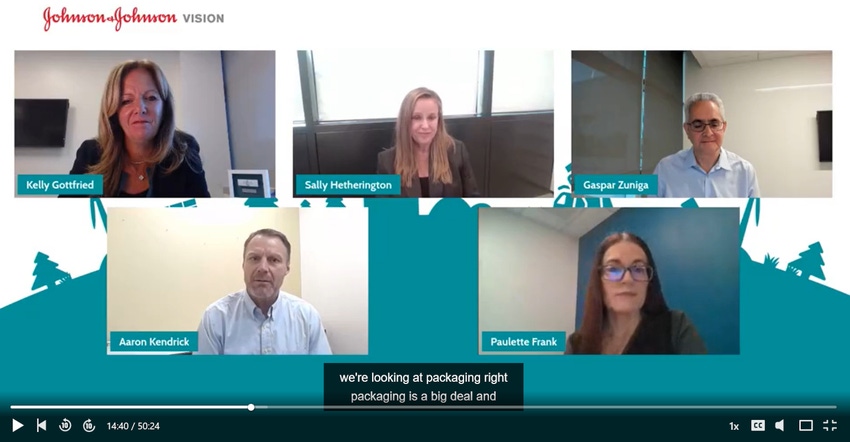J&J Vision Sets Sights on Sustainability
During a recent webinar, the vision care company shared ambitious sustainability plans for carbon neutrality, renewable energy, and optimized packaging that supports our planet.

During J&J Vision’s first ever LinkedIn live event, experts companywide spoke at length about the organization’s ongoing commitment to sustainable practices. Participants included Kelly Gottfried, head of global franchise development; Gasper Zuniga, vice president, Vision supply chain; Aaron Kendrick, senior director, value stream leader; and Paulette Frank, chief sustainability officer.
Frank began by outlining J&J Vision’s most ambitious goals to date: The desire to reduce scope 3 emissions by 20% and achieve carbon neutrality — both by 2030. J&J is also focused on running its business on renewable electricity by 2025 — a revision of the previous 2050 deadline. In fact, according to Gottfried, J&J Vision has already hit that target at its facilities in Limerick, Ireland, and Jacksonville, FL. Today, 100% of its Acuvue contact lenses are made using renewable energy sources.
Talking trash.
Reduce, reuse, recycle pervades every aspect of J&J’s business, says Kendrick. By reducing incoming material and diverting waste from the landfill via composting, recycling, and burning, the company’s surgical vision plant in Groningen, Netherlands, has close to zero waste to landfill. J&J Vision plans to replicate its efforts at other facilities in the future.
In regard to waste reduction, packaging optimization is at the forefront. The company is looking at reducing its use of paper by eliminating instructions for use.
“Wherever possible we’re going to be removing the DFU [directions for use] out of our packaging so that paper does not actually go out anymore,” says Kendrick. “We can save millions and millions of pieces of paper, which save trees. And we will supply those electronic instructions for use through an electronic means so doctors still have access to that information.”
Additionally, cartons used for packaging J&J Vision’s contact lenses are both recyclable and sourced from certified renewable forests (see video below).
“Every box of contact lenses is made from 100% sustainable paper packaging, and it’s sourced from responsibly managed forests,” notes Gottfried. “All of those outer packs and the leaflets are 100% recyclable.”
Although the blister packs that the lenses come in are made from recyclable material, Gottfried says that recycling them is not always an option due to their small size. In the United Kingdom, however, J&J has successfully partnered with TerraCycle to recycle 8.5 million contact lenses and blister packs and has plans to expand the program to other regions.
Reusable packaging designs are also on J&J’s sustainability agenda. According to Zuniga, the company’s intraocular lens (IOL) has a smartLOAD delivery technology cartridge with a reusable hand piece. The delivery system’s design also allows for a quarter of the amount of packaging used for similar device types.
The upside of downsizing.
In addition to eliminating DFUs, J&J Vision is tackling waste by shrinking the size of its packaging and shipping containers. Gottfried points out that the company has already successfully reduced the packaging of its highest selling product, Acuvue Oasys 1-day 90 pack, by 60%.
The downstream effects of reduced packaging are equally significant.
“Some of the biggest savings is in the shipment of that product, because now you can have more product on an airplane or more product in a truck that’s going somewhere, so therefore you reduce your overall carbon footprint,” says Kendrick. “So it has a knock-on effect, and that’s what we have to be able to do: We have to be able to look at items that we can impact that actually accelerate our ability to deliver sustainable results.”
Alternative packaging materials and recycling options.
J&J Vision is considering alternative materials; however, Zuniga points out that this will take time as the quality, integrity, and safety of the company’s products must be ensured as new materials are introduced.
“We cannot use biopolymers in our existing packaging. I think this is why we’re so interested in the molecular recycling.” — Gasper Zuniga, vp, J&J Vision supply chain
In response to an attendee’s question about the use of biopolymers in the company’s packaging, Zuniga gave the following response: “We cannot use biopolymers in our existing packaging. I think this is why we’re so interested in the molecular recycling.”
Several pilots are underway at J&J to explore molecular recycling as a means of facilitating the recycling of plastics. According to Kendrick, molecular recycling breaks the material down to its base components so that you cannot tell the difference between virgin and recycled material.
“Molecular recycling truly removes plastic out of the waste stream,” he says. “It removes it out of the landfill. It takes plastic that normally wouldn’t be recycled oftentimes and puts it back into that circular economy.”
Throughout the event, the speakers stressed the importance of collaborating with suppliers, partners, regulatory agencies, and customers to overcome sustainability challenges. They also indicated that they share information and learn from other projects and pilots taking place across the company.
In his closing remarks, Kendrick reiterated the important role of packaging in the company’s commitment to human health and the environment.
“Our number one commitment is to supply a safe product to our end customer, and packaging is part of delivering that safe product,” he says. “It needs to be sterile; it needs to be not damaged. All of those things need to take place. But you know what we’re finding; we can design new packaging that actually does those things that has a reduced impact on the environment. We know we can, and so we’re working on that.”
About the Author(s)
You May Also Like




